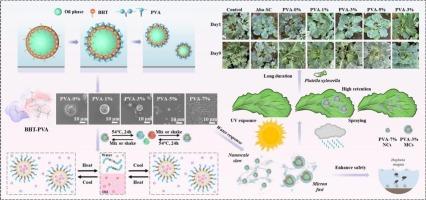氢键介导的可逆BHT/PVA纳米载体整合了缓释动力学和小尺寸协同作用,增强了农药的稳定性和寿命
IF 13.2
1区 工程技术
Q1 ENGINEERING, CHEMICAL
引用次数: 0
摘要
利用生物可降解聚合物制备载药微胶囊,平衡其缓释性能和小尺寸效应,是提高农药利用效率的有效策略。本研究以可生物降解的聚乙烯醇(PVA)和丁基羟基甲苯(BHT)为原料,设计了一步溶胶-凝胶自组装的方法来制备负载阿巴菌素的微胶囊。结果表明,PVA与BHT在o/w界面上通过氢键反应生成壳层,包封农药制成微胶囊。增加PVA用量可以减小颗粒尺寸,提高壳的稳定性。BHT的加入也提高了壳结构的稳定性和包封效率,而3 % ~ 7 %的浓度会阻碍壳结构的形成。阿维菌素具有自聚合能力,也增加了微胶囊的稳定性。保持54 °C的温度24 h以诱导乳液分离。随后的冷却和搅拌促使装载农药的微胶囊的重组。水响应机制的协同效应、高包封效率和较厚的外壳,使纳米配方比微尺度配方具有更好的缓释性能。与常规混悬液相比,阿维菌素纳米胶囊的光稳定性提高了68.26 %,在光照条件下释放60 h后,有效成分的含量仍保持在50.54 %。由于其纳米级缓释特性,生物安全性提高了36.43 %。经封装的Aba@BHT-PVA纳米体系具有优异的抗雨水侵蚀性能和叶片表面亲和性,显著延长了叶片滞留时间。与小效协同作用,对小菜蛾的防治效果和持久性均有显著提高。该工艺性能独特,易于调节,具有很大的应用价值。本文章由计算机程序翻译,如有差异,请以英文原文为准。

Hydrogen bond-mediated reversible BHT/PVA nanocarriers integrating sustained release kinetics and small-size synergy for potentiated pesticide stability and longevity
The preparation of pesticide-loaded microcapsules using biodegradable polymers and the balance between their sustained-release performance and small-size effects represent an effective strategy to enhance pesticide utilization efficiency. This study devised a one-step sol-gel self-assembly approach to fabricate abamectin-loaded microcapsules using biodegradable polyvinyl alcohol (PVA) and butylated hydroxytoluene (BHT) as raw materials. The results demonstrated that the reaction through hydrogen bonding by PVA and BHT at the o/w interface could generate shells and encapsulate pesticides to make microcapsules. Increasing PVA usage could reduce the particle size and enhance shell stability. The addition of BHT also improved the shell structure stability and encapsulation efficiency, whereas 3 %–7 % concentrations impeded the formation of the shell structure. Abamectin, which has a self-polymerizing ability, also increases microcapsule stability. A 54 °C temperature increase was maintained for 24 h to induce emulsion separation. Subsequent cooling and agitation prompts the reconstitution of pesticide-loaded microcapsules. The synergistic effect of the water-responsive mechanism, high encapsulation efficiency, and thicker shells endows nano-formulations with superior sustained-release performance compared to micro-scale formulations. The photostability of abamectin nanocapsules is significantly enhanced by 68.26 % compared to conventional suspensions, and the content of active ingredients remains at 50.54 % after 60 h of release under light conditions. Owing to their nanoscale sustained-release characteristics, their biological safety is improved by 36.43 %. The encapsulated Aba@BHT-PVA nano-system, leveraging excellent rainwater erosion resistance and leaf surface affinity, significantly prolongs its leaf retention time. Synergizing with the small-size effect, it demonstrates substantial enhancement in both the control efficacy and persistence against Plutella xylostella. Owing to its unique properties and easy regulation, this fabrication technique has great application value in the future.
求助全文
通过发布文献求助,成功后即可免费获取论文全文。
去求助
来源期刊

Chemical Engineering Journal
工程技术-工程:化工
CiteScore
21.70
自引率
9.30%
发文量
6781
审稿时长
2.4 months
期刊介绍:
The Chemical Engineering Journal is an international research journal that invites contributions of original and novel fundamental research. It aims to provide an international platform for presenting original fundamental research, interpretative reviews, and discussions on new developments in chemical engineering. The journal welcomes papers that describe novel theory and its practical application, as well as those that demonstrate the transfer of techniques from other disciplines. It also welcomes reports on carefully conducted experimental work that is soundly interpreted. The main focus of the journal is on original and rigorous research results that have broad significance. The Catalysis section within the Chemical Engineering Journal focuses specifically on Experimental and Theoretical studies in the fields of heterogeneous catalysis, molecular catalysis, and biocatalysis. These studies have industrial impact on various sectors such as chemicals, energy, materials, foods, healthcare, and environmental protection.
 求助内容:
求助内容: 应助结果提醒方式:
应助结果提醒方式:


